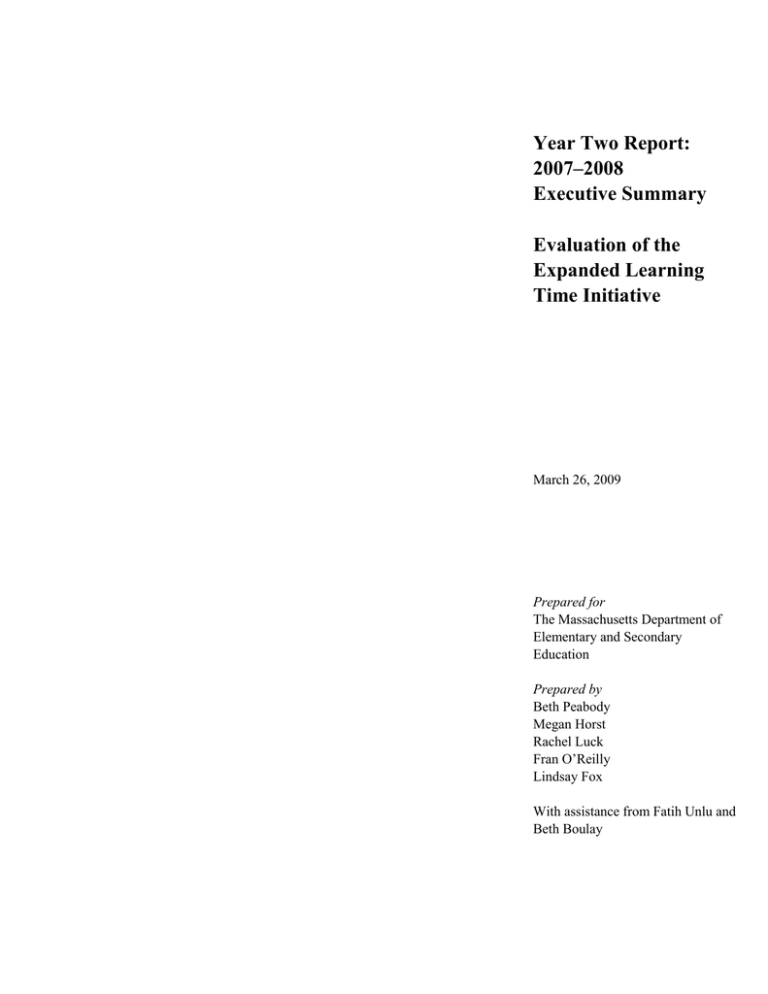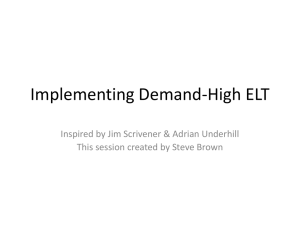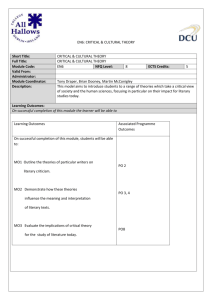03ELT YearTwo
advertisement

Year Two Report: 2007–2008 Executive Summary Evaluation of the Expanded Learning Time Initiative March 26, 2009 Prepared for The Massachusetts Department of Elementary and Secondary Education Prepared by Beth Peabody Megan Horst Rachel Luck Fran O’Reilly Lindsay Fox With assistance from Fatih Unlu and Beth Boulay Executive Summary The Massachusetts Expanded Learning Time (ELT) Initiative was established in 2005 through the funding of planning grants, which allowed schools to explore a redesign of their schedule and add time to their day or year. The first cohort of ELT schools (Cohort 1) received implementation grants to begin operating their expanded programs in the 2006–07 school year. In fall 2007, a second cohort of 9 schools (Cohort 2) implemented ELT, growing the total number of ELT schools in the Commonwealth to 18. The Evaluation of Expanded Learning Time The evaluation of ELT is a multi-year study that is being conducted as two interrelated parts: a planning and implementation component that explores the early decision-making phases and subsequent execution of ELT programs in the funded districts and schools, and an outcomes component that examines the outcomes of ELT for districts, schools, teachers, and students. The implementation and outcomes components will be linked to determine if the approaches to implementation are related to the outcomes achieved. Major Findings In the second year of ELT implementation there was continued support for the goals of the initiative among district and school personnel, parents, and community partners. With the inaugural year behind them, schools—especially the first cohort—were able to progress beyond the logistical challenges that took center stage in year one. Of particular significance was the schools’ ability to incorporate additional common planning time for teachers into their schedules, an element of ELT that had received insufficient attention in 2006–07. Our analysis of the implementation and outcomes data for year two of the initiative rendered the following notable findings: In 2006–07, a number of schools had implemented what we named a “divided schedule,” in which the expanded programming was tacked onto the end of a traditional school day. In 2007–08, the divided schedule was much less prevalent and many schools made great strides towards creating a seamless expanded day. Our interview and focus group findings indicate that another of schools’ early successes was the pace of instruction and learning that became possible with a longer day. Across cohorts, respondents reported that the pace of instruction was vastly improved with the additional time afforded by ELT, and that teachers were able to go more in depth with their lessons and provide more individualized learning opportunities to students. While it may be too early to determine if the pace of the day has an observable effect on student achievement, obtaining more detail about how teachers use the additional instructional time will be a focus of future data collection activities. Abt Associates Inc. Executive Summary 2 Several schools have yet to identify effective strategies for enrichment and working with external partners that would enhance their expanded programs. While this aspect of ELT (i.e., enrichment) is functioning very well in some schools, others are struggling to acclimate partners to the school environment. The level of funding for the initiative and its sustainability were prevalent topics in 2007– 08. Interview and focus group respondents in all stakeholder groups raised these issues, and many noted that without the state’s funding, schools would be unable to continue their expanded programs. While the Massachusetts Department of Elementary and Secondary Education (ESE) has no expectation that schools would continue to offer expanded programs without the grant, many district and school leaders noted that it would be difficult to revert to a standard schedule after having ELT. Further, most district and school leaders reported that per pupil funding was not keeping up with increased costs associated with teacher salary adjustments. That is, while the overall funding for the initiative has grown from year to year, the per pupil grant to schools has remained level. According to survey findings, teachers in ELT schools, as compared with teachers in comparison schools, were significantly more positive about the teaching environment within their schools in terms of being involved in school decision making, collaborating with fellow teachers, feeling supported in teaching special needs students, and spending more time on instruction. As is common in the early stages of new school-level initiatives, analyses revealed few effects of ELT on student outcomes for the first cohort of ELT schools. For six of the eight Massachusetts Comprehensive Assessment System (MCAS) outcomes, there was no statistically significant effect of ELT on student MCAS performance in the first or second year of ELT implementation, controlling for student demographics, prior performance, and matched comparison schools’ performance. The effects that were detected were inconsistent across grade levels. More specifically, there was a statistically significant positive effect on grade 6 MCAS math performance and a statistically significant negative effect on grade 8 MCAS math performance. Additional years of post-ELT data will help to articulate performance trends. Future Analyses An important next step is to develop an implementation index in order to explore the links between program elements and outcomes. This index and associated analyses will be included in the year three report, which will also present outcomes data for the second cohort of ELT schools. Implementation data are being collected for all three cohorts of ELT schools during the 2008–09 school year, and new instruments are being piloted to gather additional information about the specific ways time is being used in ELT and matched comparison schools. An MCAS growth model being piloted by ESE this spring will also be examined for its analytic applicability to the evaluation. Abt Associates Inc. Executive Summary 3




